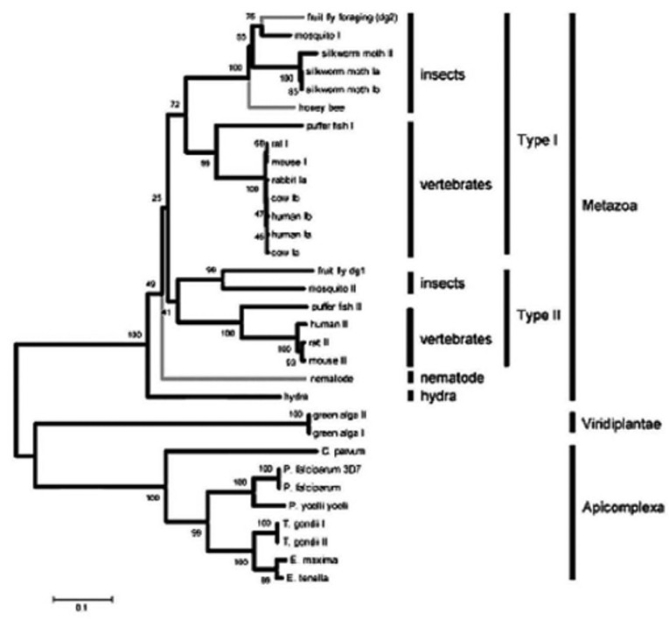Use the following information to answer the following question(s) .
The following are an abstract and figure from a paper that explores the evolutionary relationship between a protein kinase and behavior (M. Fitzpatrick and M. Sokolowski. 2004. In search of food: Exploring the evolutionary link between cGMP-dependent protein kinase (PKG) and behavior. Integrative and Comparative Biology 44:28-36) .
Abstract:
Despite an immense amount of variation in organisms throughout the animal kingdom, many of their genes show substantial conservation in DNA sequence and protein function. Here we explore the potential for a conserved evolutionary relationship between genes and their behavioral phenotypes. We investigate the evolutionary history of cGMP-dependent protein kinase (PKG) and its possible conserved function in food-related behaviors. First identified for its role in the foraging behavior of fruit flies, the PKG encoded by the foraging gene had since been associated with the maturation of behavior (from nurse to forager) in honey bees and the roaming and dwelling food-related locomotion in nematodes. These parallels encouraged us to construct protein phylogenies using 32 PKG sequences that include 19 species. Our analyses suggest five possible evolutionary histories that can explain the apparent conserved link between PKG and behavior in fruit flies, honey bees, and nematodes. Three of these raise the hypothesis that PKG influences the food-related behaviors of a wide variety of animals including vertebrates. Moreover it appears that the PKG gene was duplicated some time between the evolution of nematodes and a common ancestor of vertebrates and insects whereby current evidence suggests only the for-like PKG might be associated with food-related behavior.  These are neighbor joining trees that depict the evolutionary relationships of 32 PKG kinase domain and C-terminal amino acid sequences spanning 19 species of protozoans and metazoans. Values at the nodes represent the results of 5000 bootstrap replications. Lineages with known behavioral links with PKG are indicated by gray branches.
These are neighbor joining trees that depict the evolutionary relationships of 32 PKG kinase domain and C-terminal amino acid sequences spanning 19 species of protozoans and metazoans. Values at the nodes represent the results of 5000 bootstrap replications. Lineages with known behavioral links with PKG are indicated by gray branches.
-Look at the evolutionary relationship of protein kinases in the figure. Knowing that there is evidence that this particular protein kinase is linked to food-related behaviors in the animals studied, what conclusions can you draw?
Definitions:
Bronfenbrenner
Refers to Urie Bronfenbrenner, a developmental psychologist best known for his Ecological Systems Theory, which posits that human development is influenced by different types of environmental systems.
Microsystem
The immediate environment in which an individual directly interacts, such as family, school, or workplace, within the context of ecological systems theory.
Dizygotic Twins
Also known as fraternal twins, these are siblings born at the same time who develop from two separate eggs fertilized by two different sperm.
Fertilized Egg
An egg cell that has been penetrated by a sperm cell, beginning the process of development into a new organism.
Q10: Which of the following terms includes all
Q11: In the accompanying figure, which of the
Q15: The mechanism in which the end product
Q23: Explain how business anthropology's two primary streams
Q42: Which of the following statements regarding the
Q45: Vibrations from the tympanic membrane to the
Q49: A phospholipid is a _.<br>A) nonpolar lipid
Q53: Which of the following locations is the
Q54: Canine phosphofructokinase (PFK) deficiency afflicts Springer spaniels,
Q57: Phosphofructokinase is an allosteric enzyme that catalyzes